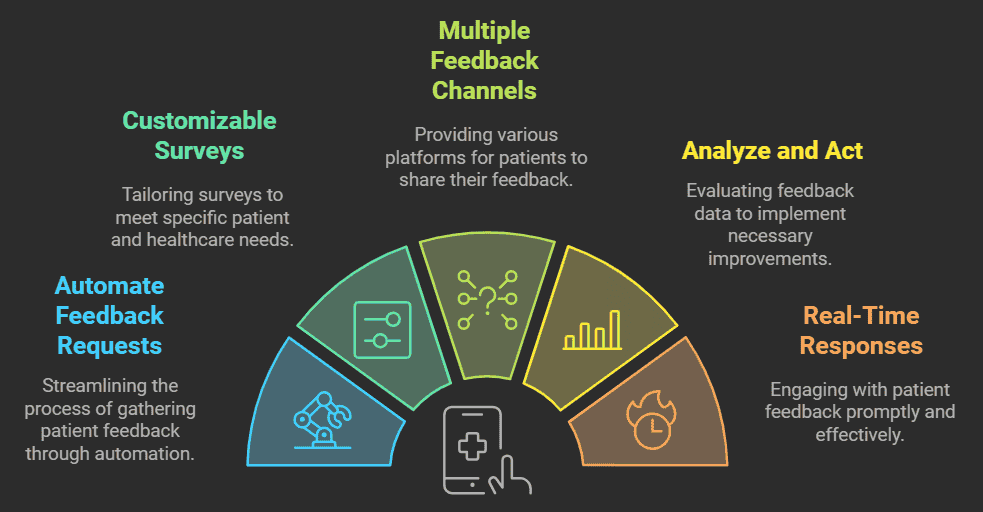The Importance of Patient Feedback
In today’s digital age, gathering patient feedback has become crucial for healthcare practices seeking to improve the quality of care and patient satisfaction. Effective feedback collection provides valuable insights into patient experiences and helps practices make informed decisions for improving service delivery. With tools like NexHealth, a robust Patient Engagement platform, healthcare providers can streamline feedback collection processes, enhance patient engagement, and foster a stronger patient relationships. In this article, we will explore how to collect patient feedback effectively using Patient Engagement software tools like NexHealth and why it is essential for the success of your practice.
Patient feedback offers a comprehensive view of how a healthcare practice is performing from the patient’s perspective. It provides insight into areas where a practice excels and identifies areas needing improvement. By gathering consistent feedback, providers can ensure that their services align with patient expectations and industry standards. Moreover, timely responses to feedback can help boost patient satisfaction, leading to more excellent retention rates, positive word-of-mouth, and even increased online reviews.
In today’s competitive healthcare landscape, patients have higher expectations. They seek personalized, attentive care, and they expect to be heard. By proactively soliciting feedback through Patient Engagement software, practices demonstrate their commitment to patient-centered care, which can foster trust and loyalty.

Why Use Patient Engagement Software?
Traditionally, collecting feedback required time-consuming methods such as paper forms or phone surveys. However, modern Patient Engagement tools, like NexHealth, have revolutionized this process, making it quicker, easier, and more efficient for both patients and providers. Patient Engagement software automates and simplifies feedback collection, offering several key benefits:
- Automated Surveys: With Patient Engagement platforms like NexHealth, practices can automatically send feedback surveys after appointments, ensuring that feedback is collected promptly while the patient’s experience is still fresh in their minds.
- Real-Time Insights: These platforms provide real-time access to patient feedback, allowing practices to address concerns and make necessary adjustments to improve service quickly.
- Patient-Centered Approach: By consistently collecting feedback, practices can demonstrate that they value patient input, which can enhance the overall patient experience and encourage patient loyalty.
- Streamlined Communication: Through automated messages and reminders, Patient Engagement platforms reduce the burden on staff to follow up with patients manually, freeing up time for more critical tasks.
- Comprehensive Reporting: Patient Engagement tools often offer detailed analytics and reporting features, allowing practices to track trends in feedback over time and measure the impact of changes in patient care.
How to Collect Patient Feedback Using Patient Engagement Software Tools Like NexHealth
NexHealth is one of the leading Patient Engagement software tools designed to simplify the patient feedback process. It integrates seamlessly into a healthcare practice’s workflow, offering tools for automating patient communication, surveys, and feedback collection. Here’s how you can use NexHealth to gather valuable patient feedback:
1. Set Up Automated Post-Appointment Surveys
One of the simplest ways to collect patient feedback is through automated post-appointment surveys. After each patient visit, NexHealth can automatically send a feedback request via email or text message, prompting patients to share their experiences. These surveys can be customized to ask specific questions about the appointment, provider interaction, facility cleanliness, wait times, and overall satisfaction.
By setting up automated surveys, you eliminate the need for staff to manually follow up with patients, ensuring a more efficient and consistent feedback collection process. Furthermore, by collecting feedback immediately after an appointment, you are more likely to capture accurate, in-the-moment impressions from patients.
2. Use Net Promoter Score (NPS) Surveys
Net Promoter Score (NPS) surveys are a valuable tool for measuring overall patient satisfaction and loyalty. With NexHealth, you can integrate NPS surveys into your feedback collection strategy to gauge how likely patients are to recommend your practice to others. NPS surveys typically ask a simple question, such as “On a scale of 0-10, how likely are you to recommend us to a friend or family member?”
Responses are then categorized into three groups:
- Promoters (9-10): Patients who are extremely satisfied and likely to recommend your practice.
- Passives (7-8): Patients who are satisfied but may not actively recommend your practice.
- Detractors (0-6): Patients who are dissatisfied and may share negative experiences.
NexHealth’s automated NPS feature allows you to gather this feedback at regular intervals, providing valuable insights into patient satisfaction levels and helping you identify areas that need improvement.

3. Monitor Feedback in Real-Time
Before, they were not afraid to switch providers if their needs were unmet. Feedback helps practices retain existing patients and attracts new ones through improved services and better online reputations. Tools like NexHealth, which focus on Patient Engagement, can automate the feedback process, making it easier for healthcare practices to gather, analyze, and act upon valuable patient insights.
What is Patient Engagement Software?
Patient Engagement Software is platform designed to enhance communication between healthcare providers and their patients. These tools help providers stay connected with patients by facilitating appointments, reminders, and communication through various channels such as text, email, and patient portals. One of the core benefits of using a Patient Engagement tool is the ability to collect and manage patient feedback seamlessly.
NexHealth, for example, is an all-in-one platform that simplifies patient communications and feedback collection. It integrates appointment scheduling, reminders, billing, and feedback mechanisms into one easy-to-use system, making it an ideal tool for busy healthcare practices.
Steps to Collecting Patient Feedback Using Patient Engagement Software Like NexHealth

1. Automate Feedback Requests
The first step in collecting patient feedback is automating the process of sending feedback requests. Rather than relying on manual follow-ups after appointments, tools like NexHealth allow you to set up automated requests triggered after a patient visit. This ensures that patients receive feedback requests at the right time—when their experience is fresh in their minds.
For instance, NexHealth can be programmed to send a feedback request via SMS or email immediately after an appointment. This saves your staff time and increases the likelihood that patients will respond, as the process is convenient and timely.
2. Use Customizable Surveys
To collect meaningful patient feedback, it’s essential to ask the right questions. Patient Engagement software like NexHealth allows practices to create customizable surveys tailored to specific services or departments. You can ask targeted questions to get deeper insights into the patient’s experience, such as:
- How was the quality of care provided?
- Were you satisfied with the communication and information provided?
- How would you rate the professionalism of the staff?
- Did you feel comfortable and informed throughout the process?
By personalizing surveys, practices can gather specific feedback that helps identify strengths and areas for improvement. Customizable surveys also ensure that the feedback collected is relevant and actionable.
3. Enable Multiple Channels for Feedback
Patients have different communication preferences, so it’s important to offer multiple channels for providing feedback. Some patients may prefer responding to an SMS survey, while others might prefer filling out a form via email or through a patient portal. Using Patient Engage tools like NexHealth, you can provide patients with the flexibility to submit feedback through the medium they are most comfortable with.
Offering multiple feedback options increases response rates and allows healthcare providers to reach a wider range of patients. Additionally, the collected data from different channels can be aggregated and analyzed in one centralized dashboard, making it easier to monitor patient satisfaction across the board.
4. Analyze and Act on Feedback
Collecting feedback is just the beginning. To truly benefit from patient feedback, healthcare practices must analyze the data and take actionable steps to address any concerns raised by patients. Patient Engagement software like NexHealth comes with built-in analytics tools that help practices categorize and assess feedback in real-time.
These tools provide valuable insights into trends, such as common complaints or frequently praised aspects of the practice. With this data, healthcare providers can make informed decisions, improve operational efficiency, and enhance the patient experience. For example, if feedback reveals long wait times as a frequent issue, the practice can focus on improving appointment scheduling and managing patient flow more effectively.
Moreover, patients appreciate when their feedback leads to visible improvements. Taking action on patient feedback fosters trust and strengthens the relationship between the practice and its patients. It also demonstrates that the practice values the patient’s input and is committed to enhancing their care experience.
5. Respond to Feedback in Real-Time
Acknowledging patient feedback—both positive and negative—goes a long way in improving patient relationships. Patient Engage platforms like NexHealth can help practices respond to feedback in real-time. Whether it’s a thank-you message for positive feedback or a follow-up message addressing a negative review, timely responses show patients that their opinions matter.
Responding to feedback in real-time not only helps address concerns quickly but also encourages patients to continue engaging with the practice. In cases where feedback is negative, a quick resolution can turn a dissatisfied patient into a loyal one, preventing them from seeking care elsewhere.
6. Leverage Feedback for Online Reputation Management
In the digital age, online reviews are critical for the success of any healthcare practice. Patients often check reviews on platforms like Google, Yelp, or Healthgrades before choosing a healthcare provider. Patient Engagement tools like NexHealth make it easy for practices to request reviews from satisfied patients and direct them to relevant online platforms.
By actively encouraging satisfied patients to leave positive reviews, healthcare practices can enhance their online reputation, attract new patients, and improve their search engine visibility. At the same time, patient feedback collected through these platforms can be used to identify areas for improvement, ensuring that the practice is always evolving to meet patient expectations.
7. Continuously Refine the Feedback Process
Patient needs and expectations evolve over time, and so should the way you collect and manage feedback. Healthcare providers must continually refine their feedback process to ensure it remains relevant and effective. Patient Engagement platforms like NexHealth provide ongoing updates and new features that allow practices to stay up to date with the latest tools for improving patient communication and satisfaction.
By reviewing the feedback regularly and making adjustments to the feedback request timing, question format, or delivery methods, healthcare providers can ensure they are gathering the most useful and actionable information from their patients.
The Benefits of Using Patient Engagement Tools for Feedback Collection
Using a comprehensive Patient Engagement tool like NexHealth offers several advantages when it comes to gathering patient feedback:
- Efficiency: Automation of feedback requests saves time and ensures a higher response rate.
- Customizability: Customizable surveys allow practices to gather relevant data.
- Analytics: Built-in analytics provide insights that help drive improvements.
- Real-time responses: Immediate feedback collection allows for quick action.
- Patient loyalty: Engaging patients in the feedback process fosters trust and long-term relationships.
Online reputation: Leveraging feedback for online reviews helps boost the practice’s online presence.
Boost Your Practice with Patient Feedback
Patient feedback is the cornerstone of improved care and satisfaction. Leverage patient engagement tools to gather actionable insights and strengthen your practice. Contact Karma Health today to implement cutting-edge solutions that empower your patients and drive your practice forward!




